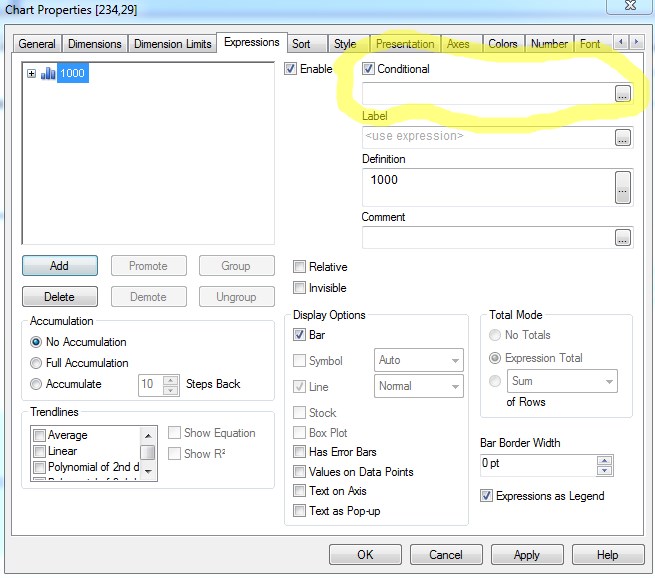Unlock a world of possibilities! Login now and discover the exclusive benefits awaiting you.
- Qlik Community
- :
- All Forums
- :
- QlikView App Dev
- :
- Re: Simple Conditional Expression on chart
- Subscribe to RSS Feed
- Mark Topic as New
- Mark Topic as Read
- Float this Topic for Current User
- Bookmark
- Subscribe
- Mute
- Printer Friendly Page
- Mark as New
- Bookmark
- Subscribe
- Mute
- Subscribe to RSS Feed
- Permalink
- Report Inappropriate Content
Simple Conditional Expression on chart
Dear all,
I have a very simple chart with only one dimension "Category" and its values are : 1,2,3,4 .
I have created a very simple chart object on which on the dimension's tab I have only the "Category" dimension and on the expression tab I want to show static numbers with the "Conditional" button enabled for each category.
For example, if Category=1 I want the expression to return 1000 , if Category=2 I want the expression to return 2000 etc.
What is the expression I should use on the conditional box in the expression tab of my chart??
Thank you all
Accepted Solutions
- Mark as New
- Bookmark
- Subscribe
- Mute
- Subscribe to RSS Feed
- Permalink
- Report Inappropriate Content
Perhaps, you don't need conditional expression but the main expression, like:
Dimension: Category
Expression: =Pick(Match(Category, '1', '2', '3', '4'), '1000', '2000', '3000', '4000')
Or,
If it follows a certain rule, try expression like: =Category*1000
- Mark as New
- Bookmark
- Subscribe
- Mute
- Subscribe to RSS Feed
- Permalink
- Report Inappropriate Content
can you share the example, I cannot understand your request very well.
- Mark as New
- Bookmark
- Subscribe
- Mute
- Subscribe to RSS Feed
- Permalink
- Report Inappropriate Content
Perhaps, you don't need conditional expression but the main expression, like:
Dimension: Category
Expression: =Pick(Match(Category, '1', '2', '3', '4'), '1000', '2000', '3000', '4000')
Or,
If it follows a certain rule, try expression like: =Category*1000
- Mark as New
- Bookmark
- Subscribe
- Mute
- Subscribe to RSS Feed
- Permalink
- Report Inappropriate Content
I want to show the static number 1000 only when Category==1. Category is on the dimension's tab and it's values are 1,2,3,4. In the following screenshot on the yellow box I need the expression to make the check if ( category==1)

- Mark as New
- Bookmark
- Subscribe
- Mute
- Subscribe to RSS Feed
- Permalink
- Report Inappropriate Content
don't use conditional
and try with this expression
pick(wildmatch(Category, '1', '2', '3', '4'), 1000,2000,3000, 4000)
- Mark as New
- Bookmark
- Subscribe
- Mute
- Subscribe to RSS Feed
- Permalink
- Report Inappropriate Content
Both answers mr tresesco and mr Massimo Grossi where correct and thank you very much for your valuable time. I hope to had the chance to mark both as correct. I wonder if anyone could inform me about any online developer guide or manual about set analysis functions and examples.
Yours sincerely,
TH
- Mark as New
- Bookmark
- Subscribe
- Mute
- Subscribe to RSS Feed
- Permalink
- Report Inappropriate Content
See attched: